Still Grasping At Straws
Businesses and cities are ditching the plastic straw, the ultimate commodity object. But the shift is controversial, and alternatives don’t come cheap.
Hey all, with all the recent chatter about straws in the news of late, we thought it would be a good idea to bring back this piece on the topic—with some sizable updates, of course. Cheers!
Sponsored By … You?
If you find weird or unusual topics like this super-fascinating, the best way to tell us is to give us a nod on Ko-Fi. It helps ensure that we can keep this machine moving, support outside writers, and bring on the tools to support our writing. (Also it’s heartening when someone chips in.)
We accept advertising, too! Check out this page to learn more.
“After bleaching, the straws are assorted by hand, each individual stalk being examined, and the imperfect ones removed. They are then cut, the five lower joints only being utilized for drinking purposes. The sheaths are then removed, and the straw washed and bound into bundles ready for the market.”
— An excerpt from The Small Grains, a book by Mark Alfred Carleton, discussing the process for creating drinking straws out of rye grass. The rye straw, while the first widely used variety of drinking straw, had some significant problems—including that the straws affected the taste of the drink and that they had a tendency to disintegrate into the beverage, leaving sediment at the bottom of the drink. These issues led to the creation of artificial straws, and while rye straws have largely faded out of the conversation, there has been at least one attempt to bring them back to life in recent years. (Another enterprising soul has recently taken to making wheat straws, too.)
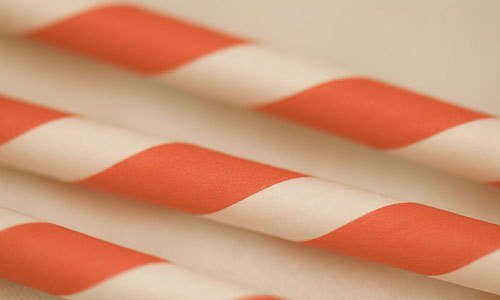
The story of the paper straw, which was no match for the plastic one
Marvin Stone, perhaps more than any other person, deserves credit for making artificial straws useful and popular. But he doesn’t deserve the blame for what straws have become.
Stone, a serial inventor who was known for manufacturing a variety of products with a cylinder shape, such as cigarette holders. Born in Ohio but based in Washington, D.C. for much of his life, he launched his career as a journalist, but eventually followed his father’s inventive spirit into the realm of manufacturing. Being a D.C. resident, he was a big fan of mint juleps, a drink popularized in the city during the 19th century by famed Kentucky Senator Henry Clay. Stone would order the drinks at Aman’s, a well-known restaurant in DC during the era—though he was disappointed by the rye straws, which had a negative effect on his drink.
Since Stone was already making cigarette holders and had recently patented a fountain pen holder, so he knew a thing or two about building cylinder-shaped objects. So he wrapped a sheet of paper around a pencil, added some glue, and suddenly he had invented the paper straw. He gave his initial supply to Aman’s for his own personal use, but found that people he ran into at the bar were impressed enough with his invention that they wanted their own. That led Stone to patent the device, and within a few years, he had cornered the market on paper straws, which became popular with the rise of soda fountains at pharmacies.
According to a 1889 article from The Lafayette Advertiser, Stone’s factory was producing 2 million straws per day not long after he filed for that patent. And when he died in 1899, Stone was well-regarded in obituaries.
“Although few pharmacists have had the pleasure of personally meeting Mr. Stone, his name is, nevertheless, known wherever there is a soda fountain,” the pharmacy trade publication The Spatula wrote at the time.
But the straws had a problem—simply, they weren’t as durable as plastic, and while they didn’t negatively affect the taste of the soda like rye straws did, they did eventually disintegrate in the beverages. By the 1960s, plastic straws, which initially carried a sense of novelty for the public because they could be made clear, had usurped the paper version entirely.
Good for plastic. Bad for the environment.
500M
The number of plastic straws used by Americans every single day, according to an estimate by the Be Straw Free campaign. (The number was reportedly figured out by a then-nine-year-old boy, making the widely cited stat somewhat suspect.) The resulting waste is difficult to recycle and often shows up in landfills, at sea, and on the beach. While a small portion of the overall waste in the ocean, the plastic is particularly dangerous for marine wildlife.
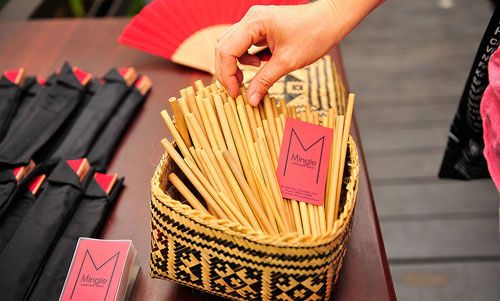
Bamboo straws, shown at a TEDx event in Indonesia. (TEDx Ubud/Flickr)
Alternative materials being used for modern-day straw design
- Bamboo: The company Brush With Bamboo, which makes a bamboo-based toothbrush (and sports support from Ed Begley Jr. on its website), also sells a set of bamboo drinking straws, which are handmade in India and designed to be reused for many years. As a result, the company sells a 12-pack of bamboo straws for $20—or more than a dollar a straw.
- Metal: If you’re OK with carrying around bamboo, how do you feel about stainless steel? If you have an aversion to BPAs, you can go the metallic route and have a straw that lasts a good long time. You probably shouldn’t bite these straws, however.
- Corn: Plastic straws have a lot of benefits for the consumer, the biggest being the design and flexibility. But sometimes, you just want a straw—one that isn’t designed to carry around or get lost. Eco-Products, a Certified B Corporation, sells plastic materials to stores and other retailers made from Ingeo, a biopolymer often produced from corn that’s compostable and renewable. While not horribly cheap compared to standard plastic straws—they sell for about a quarter a pop in small quantities—Eco-Products’ compostable straws are a lot better for the environment.
- Glass: If you’re in the mood for something a little more esoteric, you could always go with a glass straw—a niche endeavor that’s drawn mom-and-pop businesses like the Michigan company Strawesome, which glass artist Daedra Surowiec has been masterminding since 2009. “The ultimate goal is to stop having people use plastic and throwing it away after one single use. Single use plastics are wasteful. That was our goal,” Surowiec told Hometown Life last year.
- Food: Starbucks earned a whole lot of buzz a few years ago after it started selling cookie straws to go with its Frappuccinos, and it’s not a phenomenon that’s completely unheard of—candy straws and beef straws are things that exist. But perhaps the most natural approach to edible straw-making might be ice straws. Just make sure you don't want a refill.
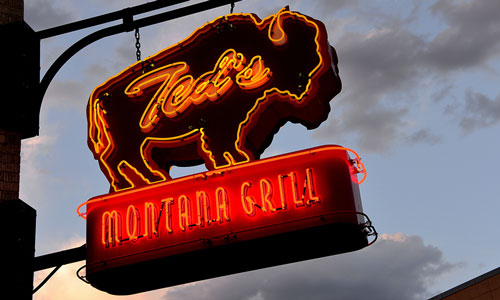
A Ted's Montana Grill location in Bozeman, Montana. (Keith Ewing/Flickr)
Ted Turner’s bison-hawking chain was woke on the issue of straw consumption nearly two decades before Starbucks even noticed
A few years ago, I called Ted Turner “the Steve Jobs of television,” as well as a “genius,” and emphasized I was not being hyperbolic by making this claim—because what he did for television in the ‘70s was genuinely groundbreaking.
Now, while Turner no longer has the level of influence and power he once did—he no longer owns Turner Broadcasting (which he regrets), and he literally gave a billion dollars to the United Nations in 1997, which probably did a number on his checkbook—he does own a lot of land, and that land contains a lot of bison. And that means that he’s well suited for being a restaurant entrepreneur.
Ted’s Montana Grill, a chain he started in 2002, is quietly an environmental maverick—the entire chain was built around the idea of ensuring the bison would stick around for generations to come by building business value around the animal. Despite the fact you’re eating bison, it’s actually hugely beneficial for the species’ long-term survival because there’s a business case for investing in ranching bison. But beyond that, Turner and his business partner George McKerrow Jr. saw an opportunity to build an eco-friendly legacy even greater than that of Captain Planet.
And the straw is kind of the key element of the whole thing. In a 2011 interview with the podcast and news site Southeast Green, McKerrow (who is also known for starting the LongHorn Steakhouse and Capital Grille chains) explained how he helped bring the paper straw back to life as a tool of environmentalism—and how it was one of the biggest challenges he faced in his efforts to minimize the amount of plastic used by the chain.
“I remember growing up with a paper straw,” McKerrow explained in an interview with the podcast’s Beth Bond. “It collapsed a lot, but heck, it was better for the environment than a plastic straw, which might be in a landfill for a hundred-plus years, or for eternity.”
McKerrow looked online for info and soon found himself on the phone with the owner of Precision Products Group—the parent company of Paramount Tube, the direct descendant of Stone's manufacturing company. McKerrow noted that paper straws hadn’t been manufactured anywhere since 1970, but that the firm was willing to pay top-dollar to get those straws. Precision had the equipment around, but it had fallen into disuse. But inspired by the phone call, the company pledged to check to see what was possible.
“About two weeks later, he got back to me, and he said, ‘We found that machine,’ and I could hear it in his voice that he was really excited,” McKerrow continued. “He said, ’The engineers think that they can make it work.’”
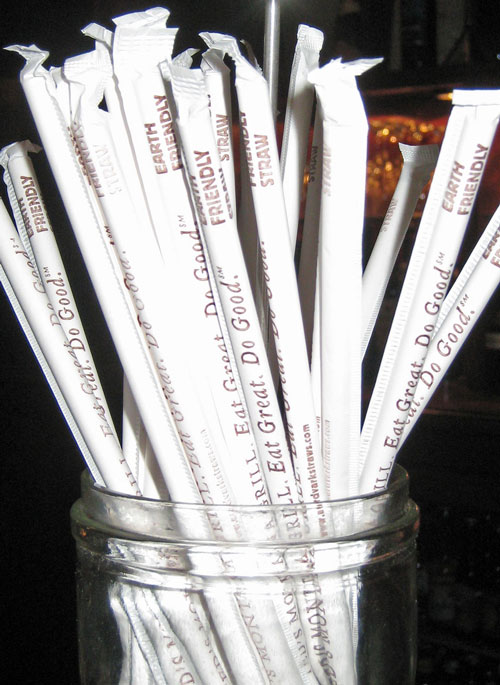
Paper straws. (Bob Simmons/Flickr)
And they did. Ted’s Montana Grill became the first company to use paper straws in more than 30 years, but the quality issues with the straws—made from paper and coated in beeswax—were still apparent, leading to customer complaints. Initially, McKerrow relented for a time, letting plastic into the cups at the restaurant, but eventually, he got a hold of Precision again, only to find that the phone call a couple years prior had led the firm to shift its entire corporate direction.
Precision, seeing a market need for eco-friendly straws, launched a brand-new subsidiary, Aardvark, to bring their paper straws back to the market.
“The story goes, we recreated a whole industry, something that was old became new again, something that was better for the environment by at least 50 percent,” McKerrow added.
They aren’t cheap—at 1.5 cents each, the cost is far above the commodity price of standard plastic straws. But in some ways the extra cost on the front end means it's a whole lot cheaper for the environment.
“Our Denver general manager first put the plan in place. It cut straw usage significantly; it's about 75 percent down.”
— Tim League, the CEO of Alamo Drafthouse, discussing with the Hollywood Reporter the theater chain’s quick moves to limit the use of straws at its company-owned locations. The company is both getting rid of plastic straws, which it plans to replace with corn-based straws at the end of the month, and, most notably, is only handing out straws if patrons ask. This policy has led to a sharp decrease in the number of straws the theaters hand out.
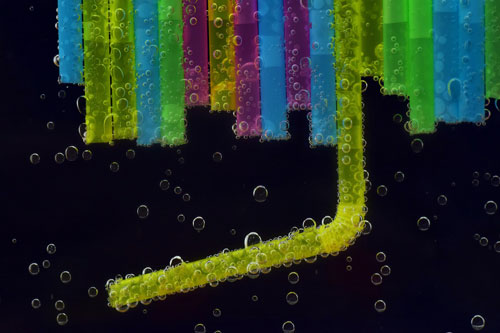
The straw issue has become a divisive, complex cultural battle. Why?
In the year-plus since this piece about straws first went online in its original form, I’ve found it to be a strangely divisive topic.
I had to write an update a few months ago as the issue picked up, and people have gotten into arguments with me about this idea. Despite the admittedly, well, tedious nature of the topic, it’s become divisive for many.
The cases against dropping plastic straws are varied, but largely, they focus around a few ideas: One, that straws are small potatoes compared to larger environmental threats like the collective use of gas-guzzling cars; two, that cutting our use of straws won’t have a sizable effect on helping the environment, particularly in the oceans, despite the fact that the movement gained momentum thanks to an incident involving a sea turtle; and three, it’s not the government’s job to regulate straws.
Obviously, the third point is one that you’re going to have a hard time arguing against, because the differences there come from an ideological place. But that just means corporations will step up instead, which is what we’re seeing with Starbucks and Alamo Drafthouse.
And there are places where, objectively, a plastic straw still makes a lot of sense compared to the alternative. One lesser-discussed angle to the issue was recently brought up by Parker Malloy, a writer for Upworthy, who made the case that the impact of dropping straws most deeply affected those with disabilities, and that they were being left aside in the conversation. Per Malloy:
What makes the entire debate over straws that much more confusing is the fact that disposable straws don't actually contribute much to the abundance of plastic waste relative to other items in the ocean. So by proposing a ban on them, we're asking disabled people to sacrifice a lot in order to gain just a little in the fight for environmental health. And by doing that, we're demonstrating a frightening lack of empathy.
The issue is complicated, especially because solutions that would otherwise be reasonable for those audiences, such as similar-looking straws made from corn, don’t really work for hot beverages. And metal straws lose the flexibility that makes plastic straws a great solution for those with disabilities.
There will always be exceptions in stories like these, and there should be room for exceptions in any discussion about the use of straws. We should not push them to the side; Starbucks should account for these issues in the midst of this larger movement.
Like fake meat, we haven’t found the perfect alternative to the real thing just yet.
The case against straws represents a starting point for a larger movement in favor of more reasonable consumption of plastics. There are some who will pooh-pooh that idea as being an example of the nanny state. There are others, though, that will support it.
But there’s room to split things down the middle here: It’s a good spot to start that’s reasonable for most and creates a potential for thoughtful design solutions to come in the future. We got the first paper straw because a guy mixing his mint juleps found the alternative lacking. Given space and an opportunity, someone will come up with an alternative that balances most of the concerns being raised here.
Straws show up everywhere. They make an excellent poster child for encouraging conscious consumption, and the fact that a nine-year-old figured that out doesn’t mean he deserves criticism. It means he deserves a high-five. He started a movement that’s showing legitimate results.
And straws don’t represent an end point for this discussion, of course. While Starbucks earns brownie points for replacing a brand icon with a glorified sippy cup, their hot cups are a tough-to-recycle mixture of paper and plastic, not unlike sauce packets and Capri Sun drinks, which each use a mixture of aluminum and plastic. That’s a good place for the next social movement to go, of course.
The problem with all these other consumables, like straws, is that they’re so insignificant that we take them for granted. Perhaps we shouldn’t.
:format(jpeg)/2017/06/tedium060617.gif)
/2017/06/tedium060617.gif)


/uploads/ernie_crop.jpg)